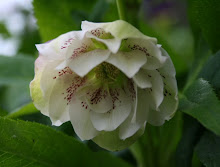Tack ALLA som hjälpt mig med namnet på denna mystiska växt som jag har i Thailand.
Det är en dvärgform av Ylang-Ylang. En Cananga fruticosa.
Här nedan finns lite information på Engelska om Ylang-Ylang.
Ylang-ylang
From Wikipedia, the free encyclopedia
(Redirected from
Ylang ylang)
Jump to:
navigation,
searchYlang-ylang
Scientific classificationKingdom:
Plantae(unranked):
Angiosperms(unranked):
MagnoliidsOrder:
MagnolialesFamily:
AnnonaceaeGenus:
Cananga
Species:
C. odorata
Binomial nameCananga odorata(
Lam.)
Hook.f. &
ThomsonYlang-ylang (IPA:
/ˈiːlæŋˈʔiːlæŋ/[1]) (ee-lang ee-lang) Cananga odorata, is a small flower of the
cananga tree. It is a fast-growing tree that exceeds 5 meters per year and attains an average height of 12
meters. It grows in full or partial sun, and prefers the acidic soils of its native rainforest habitat. The leaves are long, smooth and glossy. The flower is greenish yellow (rarely pink), curly like a
sea star, and yields a highly fragrant
essential oil. A related species is
Cananga fruticosa, which is a dwarf ylang-ylang that grows as small tree or compact shrub with highly scented flowers. Ylang-ylang has been cultivated in
temperate climates under conservatory conditions. Its fruit are an important food item for birds, such as the
Collared Imperial-pigeon,
Purple-tailed Imperial-pigeon,
Zoe's Imperial-pigeon,
Superb Fruit-dove,
Pink-spotted Fruit-dove,
Coroneted Fruit-dove,
Orange-bellied Fruit-dove, and
Wompoo Fruit-dove (Frith et al. 1976).
The name ylang-ylang is derived from
Tagalog, either from the word ilang, meaning "wilderness", alluding to its natural habitat, or the word ilang-ilan, meaning "rare", suggestive of its exceptionally delicate scent. The plant is native to the
Philippines and
Indonesia and is commonly grown in
Polynesia,
Melanesia and
Micronesia.
The
fragrance of ylang-ylang is rich and deep with notes of
rubber and
custard, and bright with hints of
jasmine and
neroli. The
essential oil of the flower is obtained through steam distillation of the flowers and separated into different grades (extra; 1; 2; 3) according to when the distillates are obtained. The main aromatic components of ylang-ylang oil are
benzyl acetate,
linalool and p-cresyl methyl ether and
methyl benzoate, responsible for its characteristic odor.
[2]The
essential oil of ylang-ylang is used in
aromatherapy. It is believed to relieve
high blood pressure, normalize
sebum secretion for skin problems, and is considered to be an
aphrodisiac.
[3] According to
Margaret Mead, it was used as such by South Pacific natives such as the
Solomons where she did much of her research. The oil from ylang-ylang is widely used in
perfumery for oriental or floral themed perfumes (like
Chanel No. 5). Ylang-ylang blends well with most floral, fruit and wood smells. In
Indonesia, ylang-ylang flowers are spread on the bed of
newlywed couples. In the
Philippines, its flowers, together with the flowers of the
sampaguita, are strung into a necklace and worn by women and used to adorn religious images.
Ylang-ylang's essential oil makes up 29% of the
Comoros' annual export (1998).
Ylang Ylang is a common ingredient in the
motion sickness medicine, MotionEaze.






 Här nedan finns lite information på Engelska om Ylang-Ylang.
Här nedan finns lite information på Engelska om Ylang-Ylang.

 Most of the flowers in a Thaigarden are growing in potts.... not in the grownd.
Most of the flowers in a Thaigarden are growing in potts.... not in the grownd. 








